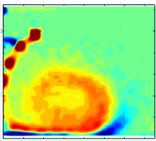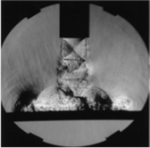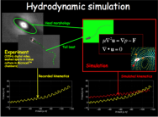Aerodynamics, Fluid Mechanics, Flight and Flow Control
Fluid mechanics is a fascinating and important branch of science and engineering, and the Aerospace Sciences Division has diverse research interests in phenomena relevant to fixed and rotary wing aircraft; aeroelasticity; flow control; vortex dominated flows; turbomachinery; renewable energy devices including wind and marine turbines; fluid-structure interactions; unsteady shock waves and detonations; shock-boundary layer interactions; low- and high-speed aerodynamics; and advanced flow diagnostics. A range of industrial organisations and government agencies provides external support for these projects: EPSRC, Rolls-Royce, SWIFT, BAE Systems, US Army, Dowty Propeller, CAA, Clean Skies, and DSTO Australia, to name a few.
Computer systems are available with mature and diverse CFD codes, either in-house developed or the latest commercially available codes, for fluid flow simulation. These are complemented with a range of specialist equipment including research microscopes, low- and high-speed wind tunnels and shock tubes equipped with diverse test rigs and state-of-the-art measurement technology such as pressures sensitive paints, particle image velocimetry, and infra-red tomography to aid experimental investigations.
Research topics
Staff
| Dr. Craig White |
| Dr. Euan McGookin |
| Dr. Angela Busse |
| Dr. Richard Green |
| Prof. Konstantinos Kontis |
Quick Links
Apply for a PhD
More PhD Topics
Related Themes
Dynamics, Avionics, Navigation and Control
Rotor Aerodynamics
Helicopter rotor blades trail vortices that are persistent and remain in the vicinity of the rotor disk for a long time. This affects the aircraft performance, causes noise and vibration, and can lead to hazardous flight regimes. Activity at Glasgow to investigate helicopter rotor aerodynamics has been on-going for many years, and projects include vortex interaction phenomena, ground effect, vortex ring state and drag reduction strategies. The work has been conducted in wind tunnels using particle image velocimetry to measure whole flow fields, high density arrays of pressure transducers, and load cell systems for force and moment measurement. Our investigation into rotor aerodynamics also extends to propellers and airscrews at incidence.
Compressible Flows
Travelling at high speeds entails overcoming adverse effects such as regions of high heat transfer and surface pressures, unsteady shock waves and their interactions, fluid-thermal-structure interactions, together with the requirement of drag reduction and improved propulsive efficiency. By employing and developing the very latest in advanced fluid diagnostics and experimental facilities we, at Glasgow University, tackle some of the most challenging and important problems within the aerospace industry from unsteady shock-boundary layer interactions to the application of novel plasma effectors for flow control.
Turbulent Flow Over Complex Surfaces
Complex surfaces, such as rough or super-hydrophobic surfaces, occur in many engineering applications. Surface roughness can be caused by many processes, e.g. fuel deposition, pitting, biofouling, and other forms of surface decay, and will in general increase drag. Super-hydrophobic surfaces are inspired by the Lotus-leaf effect and combine a hydrophobic surface chemistry with a surface structure on micro- and nanoscales. Super-hydrophobic surfaces can reduce skin-friction drag and have applications to transport of liquids in pipes and to watercraft.
In a current project in collaboration with the University of Southampton the influence of different forms of marine biofouling on wall-bounded turbulent flow is investigated to obtain an accurate prediction of the friction factor over a wide range of Reynolds numbers from the transitionally to the fully rough regime.
Bio-Inspired Engineering
Dr. Eric Gillies, Dr. Richard Green, Dr. Euan McGookin
The design of modern aircraft require a balance between paramters such as aerodynamic performance, propulsive efficiency, structural weight and integrity (to endure aeroelastic effects for example), aircraft systems, and environmental impact. Aircraft design also relates to upgrades and modification to existing platforms, such as addition of modern scientific instruments to examine phenomena such as ash cloud dispersion. A recent project within Glasgow University in collaboration with C2 Aviation, Kemble, and the Facility for Airborne Atmospheric Measurement of Cranfield University, has included use of the Canberra XH134 stratospheric atmospheric research vehicle.




